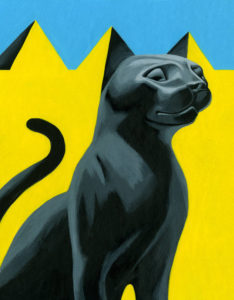Ever since they were worshiped in ancient Egypt, cats have occupied an uncanny place in the world’s imagination
The Wall Street Journal, October 22, 2018

ILLUSTRATION: THOMAS FUCHS
As Halloween approaches, decorations featuring scary black cats are starting to make their seasonal appearance. But what did the black cat ever do to deserve its reputation as a symbol of evil? Why is it considered bad luck to have a black cat cross your path?
It wasn’t always this way. In fact, the first human-cat interactions were benign and based on mutual convenience. The invention of agriculture in the Neolithic era led to surpluses of grain, which attracted rodents, which in turn motivated wild cats to hang around humans in the hope of catching dinner. Domestication soon followed: The world’s oldest pet cat was found in a 9,500 year-old grave in Cyprus, buried alongside its human owner.
The Egyptians were unique in their extreme veneration of cats, but they weren’t alone in regarding them as having a special connection to the spirit world. In Greek mythology the cat was a familiar of Hecate, goddess of magic, sorcery and witchcraft. Hecate’s pet had once been a serving maid named Galanthis, who was turned into a cat as punishment by the goddess Hera for being rude.
When Christianity became the official religion of Rome in 380, the association of cats with paganism and witchcraft made them suspect. Moreover, the cat’s independence suggested a willful rebellion against the teaching of the Bible, which said that Adam had dominion over all the animals. The cat’s reputation worsened during the medieval era, as the Catholic Church battled against heresies and dissent. Fed lurid tales by his inquisitors, in 1233 Pope Gregory IX issued a papal bull, “Vox in Rama,” which accused heretics of using black cats in their nighttime sex orgies with Lucifer—who was described as half-cat in appearance.
In Europe, countless numbers of cats were killed in the belief that they could be witches in disguise. In 1484, Pope Innocent VIII fanned the flames of anti-cat prejudice with his papal bull on witchcraft, “Summis Desiderantes Affectibus,” which stated that the cat was “the devil’s favorite animal and idol of all witches.”
The Age of Reason ought to have rescued the black cat from its pariah status, but superstitions die hard. (How many modern apartment buildings lack a 13th floor?). Cats had plenty of ardent fans among 19th century writers, including Charles Dickens and Mark Twain, who wrote “I simply can’t resist a cat, particularly a purring one.” But Edgar Allan Poe, the master of the gothic tale, felt otherwise: in his 1843 story “The Black Cat,” the spirit of a dead cat drives its killer to madness and destruction.
So pity the poor black cat, which through no fault of its own has gone from being an instrument of the devil to the convenient tool of the horror writer—and a favorite Halloween cliché.





